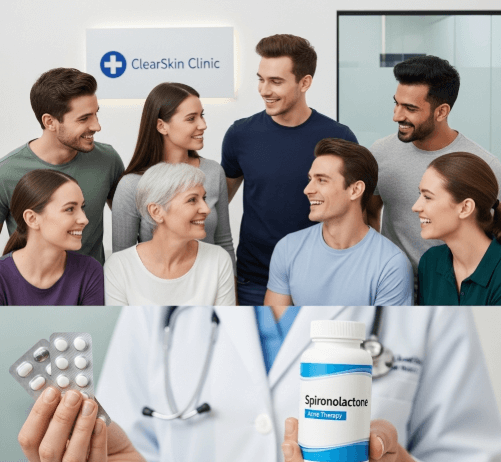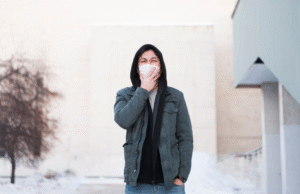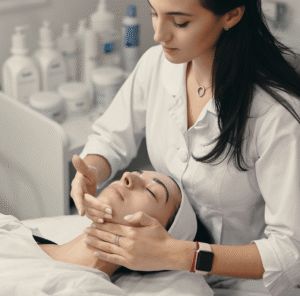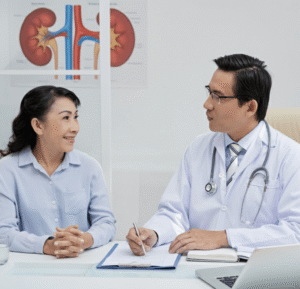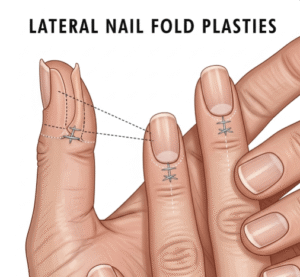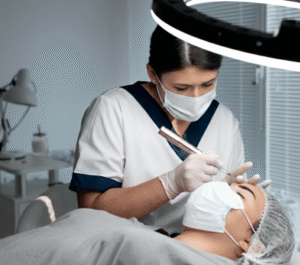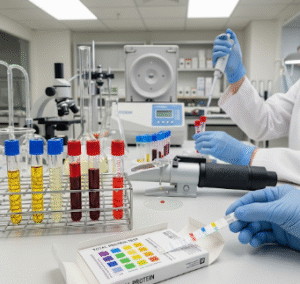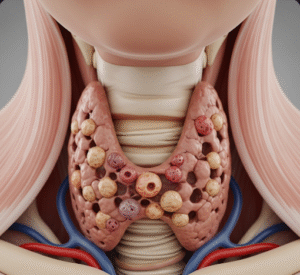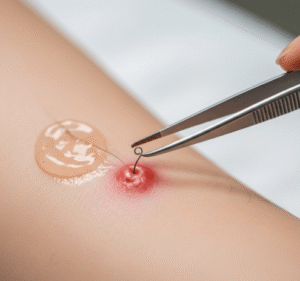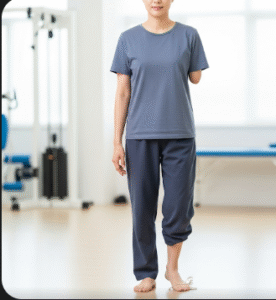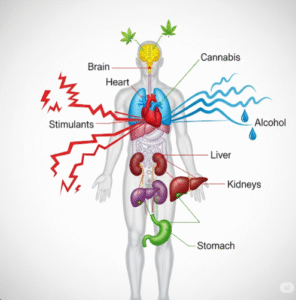A Hormone-Targeting Approach for Clearer Skin
What it is
Spironolactone is a medication originally developed as a diuretic and blood pressure regulator, but it has become widely recognized in dermatology as an effective treatment for hormonal acne. It works by blocking androgen (male hormone) receptors and reducing sebum (oil) production in the skin.
→ In acne therapy, spironolactone is prescribed off-label (meaning not for its original medical use but backed by evidence of effectiveness).
➝ It is especially recommended for adult women who suffer from persistent acne on the jawline, chin, or lower face — areas typically influenced by hormonal activity.
➔ Unlike antibiotics or topical creams, spironolactone targets the internal hormonal imbalance that contributes to acne flare-ups.
Why it’s done
Spironolactone acne therapy is used because many adults — particularly women — experience acne that does not respond well to over-the-counter skincare or topical prescription creams.
- Hormonal fluctuations ⇒ Menstrual cycles, polycystic ovary syndrome (PCOS), or other endocrine changes may trigger acne that needs hormonal regulation rather than surface-level treatment.
- Resistance to other therapies ⇒ Some patients have tried antibiotics, benzoyl peroxide, or retinoids with little success.
- Long-term control ➳ Spironolactone offers a solution that manages acne without relying on harsh antibiotics or repeated topical irritation.
- Quality of life ➟ Clearer skin reduces emotional stress, improves self-confidence, and helps patients avoid scarring.
Alternatives
Not every patient is suited for spironolactone. Alternatives include:
→ Topical treatments: Retinoids ; benzoyl peroxide ; topical antibiotics (clindamycin).
➝ Oral antibiotics: Such as doxycycline or minocycline for short-term flare control.
➔ Hormonal birth control pills: These regulate estrogen and progesterone, which also impact acne severity.
⇒ Isotretinoin (Accutane): A strong systemic treatment for severe cystic acne, though it has more potential side effects.
➟ Non-medication approaches: Light therapy ; chemical peels ; or dietary management (reducing high-glycemic foods).
Preparation
Before beginning spironolactone acne therapy, several steps are essential:
➳ Medical consultation: Only a dermatologist or physician can determine whether spironolactone is safe and appropriate.
➝ Blood tests: Baseline checks for kidney function and potassium levels are often recommended, since spironolactone affects electrolyte balance.
→ Review of current medications: Some drugs (like ACE inhibitors or potassium supplements) may interact dangerously with spironolactone.
➟ Pregnancy status: Spironolactone should not be taken during pregnancy due to risks of fetal harm ; contraception is usually required while on therapy.
➔ Lifestyle preparation: Patients should be informed about possible side effects, dietary adjustments, and the need for consistent treatment over several months.
How it’s Done
Spironolactone acne therapy involves a step-by-step medical approach under professional supervision.
Prescription and Dosing
→ Spironolactone is taken orally in pill form, usually starting at 25–50 mg per day, then gradually increasing up to 100–200 mg per day depending on response and tolerance.
➝ The therapy is long-term — results may take 3 to 6 months to appear, as hormonal changes stabilize.
➔ Dosage adjustments are common ; dermatologists monitor the skin’s response and any side effects.
Combination Therapy
→ Spironolactone is often combined with topical treatments such as retinoids, azelaic acid, or benzoyl peroxide to maximize results.
➝ Some women are prescribed both oral contraceptives and spironolactone for enhanced hormonal balance.
➔ In severe cases, dermatologists may rotate spironolactone with short courses of antibiotics to quickly control flare-ups.
Lifestyle Integration
→ Patients are encouraged to maintain a healthy diet low in excess salt and high in hydration.
➝ Avoiding potassium-rich foods (bananas ; avocados ; coconut water) may be recommended to prevent electrolyte imbalances.
Recovery
Recovery in spironolactone therapy is less about physical downtime and more about adaptation to treatment.
→ Initial side effects may include dizziness, increased urination, or mild breast tenderness, which often resolve within weeks.
➝ Acne improvement is gradual ; many patients see clearer skin after 8–12 weeks, with optimal results at around 6 months.
➔ Long-term recovery means maintaining hormonal balance and preventing new acne scars.
➟ Stopping spironolactone suddenly can sometimes trigger acne relapse, so tapering under medical guidance is advised.
Complication
While generally safe, spironolactone therapy has potential risks:
→ Electrolyte imbalance: High potassium levels (hyperkalemia) can occur if not monitored.
➝ Menstrual irregularities: Some women experience spotting, irregular cycles, or breast tenderness.
➔ Fatigue or dizziness: Related to its mild diuretic effect.
⇒ Pregnancy risk: The drug is unsafe for pregnant women because it can affect fetal development.
➟ Drug interactions: Combining spironolactone with blood pressure medications or potassium supplements may cause complications.
Treatment option in Korea
In South Korea, spironolactone acne therapy is increasingly recognized as part of modern dermatology practice.
→ Dermatology Clinics: Major skin hospitals in Seoul, Incheon, and Busan now provide spironolactone therapy for women with resistant hormonal acne.
➝ Integrated Treatment Plans: Korean dermatologists often combine spironolactone with K-beauty skincare routines focusing on hydration and barrier repair.
➔ Monitoring Programs: Regular follow-up visits and lab checks are standard, ensuring safety and customized dosing.
➟ Alternative Hormonal Treatments: For patients unable to take spironolactone, Korean dermatologists may recommend low-dose oral contraceptives or safe topical hormone modulators.
⇒ Supportive Skincare Products: Korean brands like COSRX, Etude, and Laneige provide gentle cleansers, soothing essences, and non-comedogenic moisturizers designed to complement medical acne therapy.

